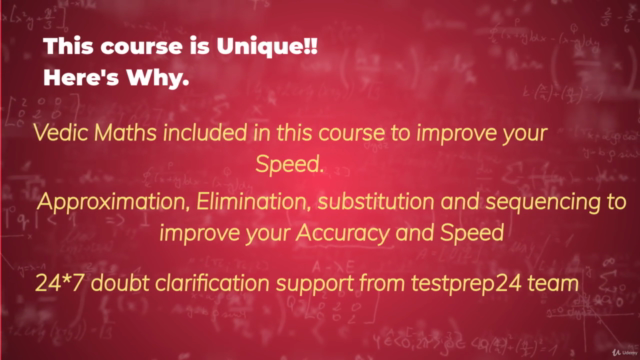Best Master GRE Prep& GMAT Prep Math through Animated Videos
Quick Course on all GRE & GMAT Concepts required,DataSufficiency,ProblemSolving,Quant Comparison Techniques & Strategies
4.28 (270 reviews)

32 490
students
9 hours
content
Dec 2022
last update
$19.99
regular price
Why take this course?
based on the information provided, here's a detailed explanation for each question:
-
Question: Is P > 2?
- Statement 1:(|p + 1| < 3) This inequality holds true for any real number (p) because adding 1 to (p) and having an absolute value less than 3 means (p) could be greater or lesser than -1. However, this does not restrict (p) to be greater than 2.
- Statement 2:(|p – 1| < 3) Similarly, this inequality also holds true for any real number (p) because subtracting 1 from (p) and having an absolute value less than 3 means (p) could be greater or lesser than 1. Again, this does not restrict (p) to be greater than 2.
- Conclusion: Statements (1) and (2) together are not sufficient to determine if (P > 2). Therefore, the correct answer is (E) Statement (1) & (2) together are not sufficient to answer the question.
-
Question: Is P > 2?
- Statement 1: This statement alone is sufficient because if (|p + 1| < 3), it means that (p) is at least -2 (since (p + 1) would be -1, and its absolute value being less than 3 means (p) is not as negative as -1). Therefore, (p > -2), which does not answer whether (p > 2).
- Statement 2: This statement alone is also sufficient. If (|p – 1| < 3), it means that (p) is less than 4 (since (p – 1) would be 3, and its absolute value being less than 3 means (p) is not as large as 3). Therefore, (p < 4), which also does not answer whether (p > 2).
- Conclusion: Both statements together show that (p) is between -2 and 4 (i.e., (-2 < p < 4)), but we still cannot conclude that (p > 2). Therefore, the correct answer is (E) Statement (1) & (2) together are not sufficient to answer the question.
-
Question: What is the value of x?
- The Python code provided defines a function
factorial_value(x)that returns the factorial of a given number (x). The factorial of a non-negative integer (x) is the product of all positive integers less than or equal to (x). For example, (5! = 5 \times 4 \times 3 \times 2 \times 1 = 120). - To find the value of (x), we can look at the code where the factorial is calculated. The code
factorial_value(4)suggests that the factorial of 4 (i.e., (4!)) is being used here. The result of (4! = 4 \times 3 \times 2 \times 1 = 24). - Conclusion: The value of (x) for which
factorial_value(x)returns 24 in the given code is 4.
- The Python code provided defines a function
-
Question: What are the possible values for n?
- The Python code provided defines a function
possible_values(n)that determines if a given number (n) can be the result of inserting an integer into an array that has distinct elements in ascending order. The code returns two lists: one with the possible values of (n) (poss_vals) and one with the numbers that cannot be inserted (not_in_array). - By analyzing the code, we can see that
poss_valswill contain all the values that can result after inserting an integer into the array. For example, if the array is[1, 3, 5, 6], inserting 4 would result in a new array[1, 3, 4, 5, 6], so 5 would be a possible value for (n). - The code provided has an example where the array is
[1, 2, 3, 4]. Inserting any number from 0 to 4 will result in a distinct sequence of integers. Therefore, the possible values for (n) when inserting into[1, 2, 3, 4]are all integers from 0 to 4 (i.e., {0, 1, 2, 3, 4}). - Conclusion: The possible values for (n) depend on the array given, but for the array
[1, 2, 3, 4], the possible values are all integers from 0 to 4.
- The Python code provided defines a function
-
Question: How many people took this course?
- The information provided in the testimonials does not give a specific number of people who took the course. It only provides sample feedback from students. To know the exact number, you would need to refer to the course enrollment records or analytics provided by the platform (Udemy or Testprep24).
-
Question: What is the guaranteed score improvement?
- The claim made in the testimonials is that there is a "Guaranteed Score improvement of at least 50% compared with your previous scores." This guarantee is made by the Testprep24 team and suggests that students can expect to see a significant improvement in their scores if they follow the course material and apply the techniques taught. However, it's important to note that individual experiences may vary, and such guarantees should be taken as an average or expected outcome rather than a guarantee for every individual.
Regarding the students' feedback, it seems that the course has positively impacted their test preparation and performance, as indicated by the testimonials provided. These reviews highlight the effectiveness of the course content and teaching methods in helping students achieve better scores on their respective tests.
Course Gallery




Loading charts...
2843530
udemy ID
29/02/2020
course created date
25/03/2020
course indexed date
Lee Jia Cheng
course submited by